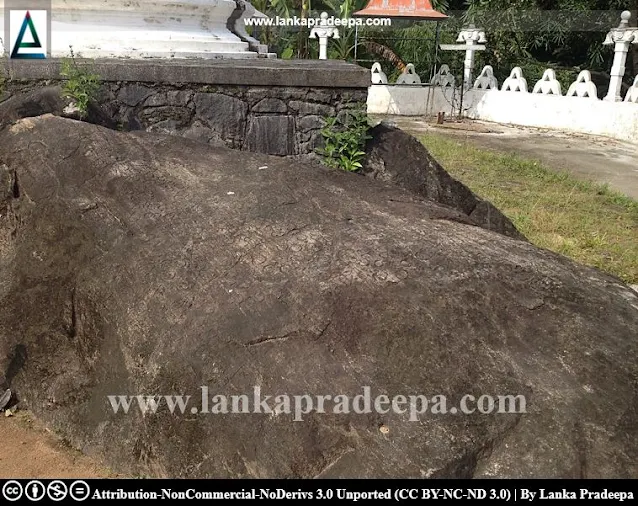
Uda Aludeniya Raja Maha Viharaya (Sinhala: උඩ අළුදෙණිය විහාරය) is a Buddhist temple situated in Uda Aludeniya village in Kandy District, Sri Lanka. The site can be reached by travelling about 750 m distance along Uda Aludeniya - Thalawathura road from the Weligalla Junction.
History
The history of Uda Aludeniya Viharaya runs back to the 14th century. It is believed that this temple was constructed or restored by Mayim Bandara during the reign of King Bhuvanekabahu IV [(1341-1351 A.D.) Codrington, 1933; Lewis, 1922; Mudiyanse, 1960; Seneviratna & Polk, 1992; Withanachchi, 2018]. King Parakramabahu V (1351-1359 A.D.) is said to have contributed to the development of this temple (Withanachchi, 2018).
According to folklore, a Buddhist monk named Chandrajothi Sthavira who was a member of the royal family went on a long journey and when he was returning he got benighted at this village which was then inhabited by people of the Chaliya caste (Lewis, 1922). Owing to the inhospitality of the villagers he had to spend the night in a cave there and on arriving at Gampola he reported this behaviour of villagers to the king (Lewis, 1922). The king who was displeasure by hearing this incident drove them out of the village to Selawa in four Korales (Lewis, 1922). Further, he built the present temple and gave it a gold Buddha image and lands (Lewis, 1922).
Artefacts
Presently, the temple has been completely renovated and only a few original structures such as a wooden door-frame, a rock inscription, and a Sandakada Pahana (moonstone) can be identified in the temple premises.
The door-frame

The wooden door frame which is found in the image house is called Rambawa (Seneviratna & Polk, 1992; Withanachchi, 2018). This antiquarian door frame is richly carved with floral and vegetable designs with the figures of dancers, musicians, and guardians (Seneviratna & Polk, 1992). The door frame carries great significance as it is considered one of the examples of the earliest wooden carvings found in the country (Seneviratna & Polk, 1992).
The Stupa and the inscription
Beside the door frame, a small Stupa and a rock inscription belonging to the 18th century can be seen near the image house of the temple. The inscription is said to have been written in 1742 [reign of King Sri Vijaya Rajasinghe (1739–1747)] by a Buddhist monk named Chandrajothi Thera (Rajapakse, 2016; Senanayaka, 2018; Withanachchi, 2018).
Excavations & findings
From the excavations done in 2004, a relic casket adorned with a large number of miniature seated Buddha statues (about 125 images) was discovered in the chamber of the ruined brick Stupa at Uda Aludeniya temple (Withanachchi, 2018). These Buddha statues were placed around a silver Stupa covering a gold dome-shaped relic container which is said to contain seven tiny bone fragments wrapped in gold foils (Stadtner, 2015). Another small reliquary with seated bronze Buddha statues was also found (Stadtner, 2015). After the conservation of the Stupa, the discovered artefacts were gifted to the National Museum of Colombo by the chief incumbent of the temple, Ven. Gangoda Chandaloka Thera.


.

Reliquary - Uda Aludeniya (14th century)
This bronze reliquary (left photograph) was discovered in the relic chamber of the Stupa at Uda-Aludeniya Viharaya (Prematilaka & Hewage, 2018). The large casket contained two concentric tiers of seated Buddha images of miniature sizes. Middle of the casket was a small silver reliquary containing corporeal relics. Several other circles of Buddha images were also found placed around the large enveloping reliquary (above left photograph). These Buddha images are in Samadhi and Bhusparsha-mudra and are seated in Padmasana. It is believed that these images have been imported from South India.
A protected site
The ancient wooden door frame, inscription, and Sandakada Pahana situated in the premises of Uda Aludeniya Raja Maha Viharaya in the Divisional Secretary’s Division of Udunuwara are archaeological protected monuments, declared by a government gazette notification published on 23 February 1967.
References
1) Codrington, H.W., 1933. The Gampola Period of Ceylon History. Journal of the Ceylon Branch of the Royal Asiatic Society, (86), pp.260-309.
2) Mudiyanse, N., 1960. The art and architecture of the Gampola Period (1341-1415). M. D. Gunasena. p.19.
3) Lewis, J.P., 1922. Kandyan Notes. The Ceylon Antiquary and Literary Register. Vol: VII, Part: II. p.108-113.
4) Prematilaka, L., Hewage, R., 2018. A guide to the National Museum,
Colombo: Department of National Museum. ISBN: 978-955-578-035-3. pp.1-2.
5) Rajapakse, S., 2016. Pauranika Sthana Ha Smaraka: Mahanuwara Distrikkaya (In Sinhala). Archaeological Department of Sri Lanka. ISBN:955-9159-34-8. p.72.
6) Senanayaka, P., 2018. Senkadagala Mahanuwara pradeshaye peranima Bauddha Vihara Arama (In Sinhala). Samodhana, The Journal of Faculty of Social Sciences and Humanities. Vol.7 (1). pp.55-83.
7) Seneviratna, A. and Polk, B., 1992. Buddhist monastic architecture in Sri Lanka: the woodland shrines. Abhinav Publications. pp.125-126.
8) Stadtner, D.M., 2015. Rajadhiraj’s Rangoon Relics and a Mon Funerary Stupa. Journal of the Siam Society, 103.
9) The Gazette notification. No: 14737. 23 February 1967.
10) Withanachchi, C.R., 2018. Madyama palate Rajamaha Viharasthana
(In Sinhala). Report on the ancient Buddhist temples in the Central
Province of Sri Lanka which were royally sponsored during the Kandy
period. p.15.

